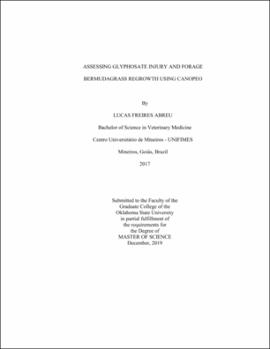| dc.contributor.advisor | Rocateli, Alex | |
| dc.contributor.author | Freires Abreu, Lucas | |
| dc.date.accessioned | 2021-04-06T16:02:48Z | |
| dc.date.available | 2021-04-06T16:02:48Z | |
| dc.date.issued | 2019-12 | |
| dc.identifier.uri | https://hdl.handle.net/11244/329094 | |
| dc.description.abstract | Applications of glyphosate for weed control in bermudagrass pastures are permitted; however, product labels are vague regarding use after spring green-up. In-season weed control with glyphosate could be a feasible option if bermudagrass tolerance to glyphosate was better understood. Also, a quantitative method might improve glyphosate injury assessment. The objective of this study was to evaluate the tolerance of bermudagrass cultivars Goodwell and Greenfield to varying glyphosate rates and develop a quantitative methodology to determine glyphosate injury based on relative green canopy cover (RGCC). The experimental design was a completely randomized factorial containing the two bermudagrass cultivars and five glyphosate rates (0.4, 0.5, 1.1, 1.5, and 3.1 kg a.i. ha-1) plus a nontreated control. Visual green canopy cover (VGCC) and RGCC ratings were collected at 8, 16, 24, 37, and 56 days after glyphosate application (DAG), and biomass from canopy regrowth following applications was collected at 56 DAG. The root mean square difference (RMSD) values indicated that agreement between methodologies decreased at later days after glyphosate application. The visual capability to estimate glyphosate injury was not as precise as the RGCC method, which measures green color at the pixel level. The fractional green canopy cover (FGCC) results indicated greater glyphosate injury of Greenfield than Goodwell at 24 DAG. At 56 DAG, canopy regrowth of Greenfield and Goodwell was lower than the control at glyphosate rates of 1.1 and 3.1 kg a.i. ha-1, respectively. Thus, improved glyphosate recommendations for bermudagrass could be cultivar specific. | |
| dc.format | application/pdf | |
| dc.language | en_US | |
| dc.rights | Copyright is held by the author who has granted the Oklahoma State University Library the non-exclusive right to share this material in its institutional repository. Contact Digital Library Services at lib-dls@okstate.edu or 405-744-9161 for the permission policy on the use, reproduction or distribution of this material. | |
| dc.title | Assessing glyphosate injury and forage bermudagrass regrowth using Canopeo | |
| dc.contributor.committeeMember | Arnall, Brian | |
| dc.contributor.committeeMember | Manuchehri, Misha | |
| osu.filename | FreiresAbreu_okstate_0664M_16530.pdf | |
| osu.accesstype | Open Access | |
| dc.type.genre | Thesis | |
| dc.type.material | Text | |
| dc.subject.keywords | bermudagrass | |
| dc.subject.keywords | canopeo | |
| dc.subject.keywords | forages | |
| dc.subject.keywords | glyphosate tolerance | |
| thesis.degree.discipline | Plant and Soil Sciences | |
| thesis.degree.grantor | Oklahoma State University | |
